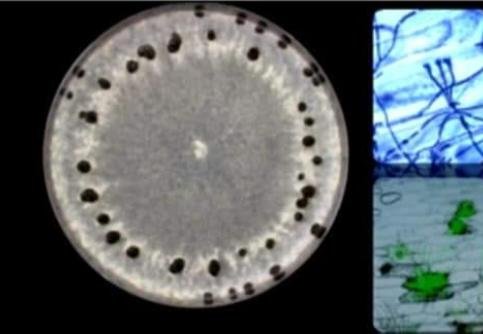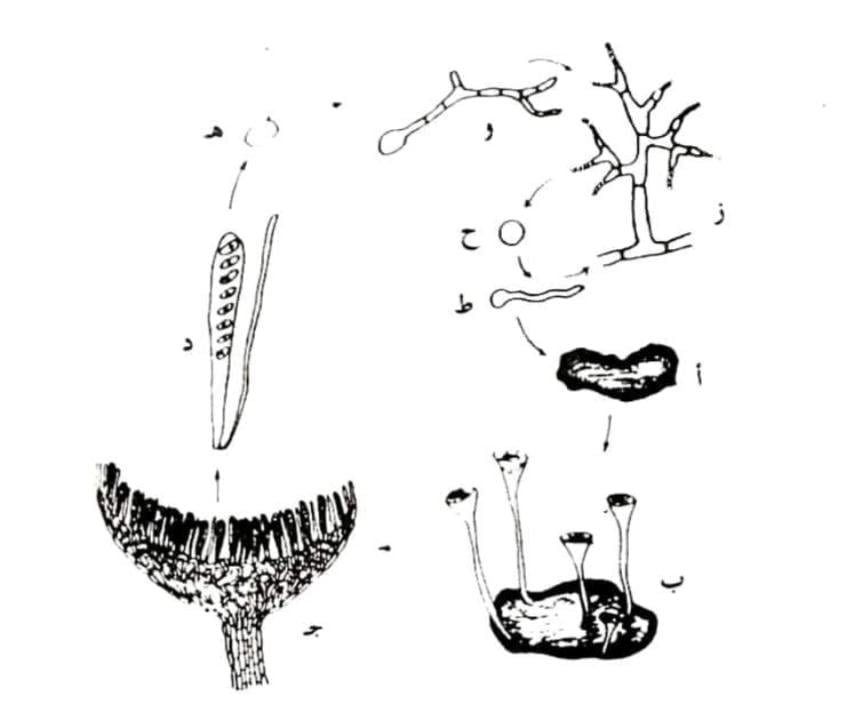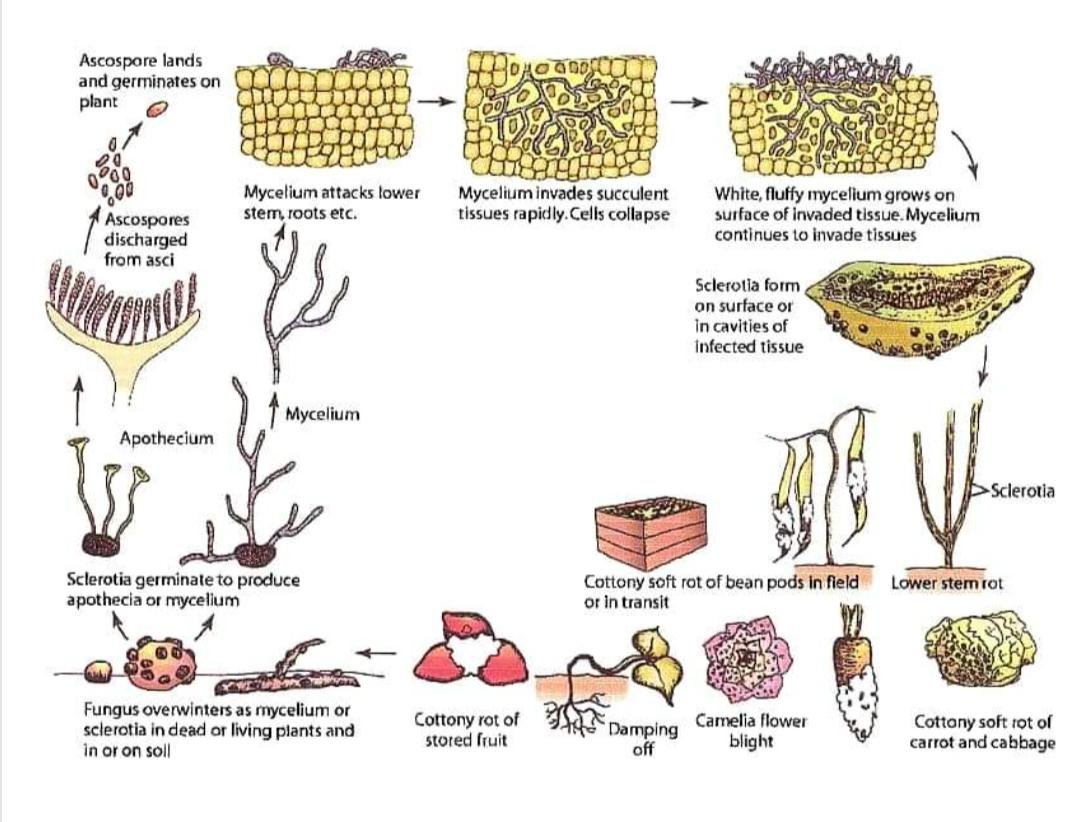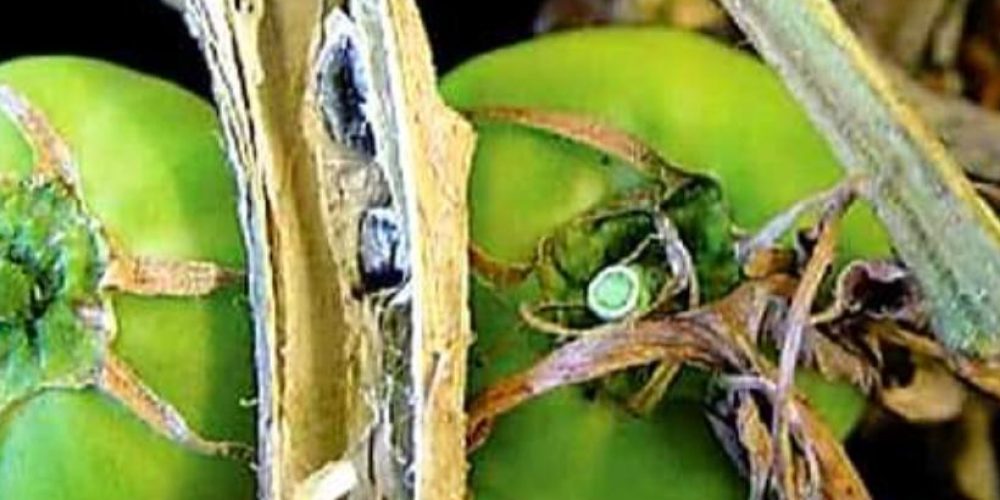Table of contents of the article
ToggleWhite mold in tomatoes is considered a fungal disease that specifically affects tomato plants. In this article on your website, World of Plants, we discuss the symptoms of the disease and ways to deal with it.
Spread of white mold disease in tomatoes
White rot disease in tomatoes (sclerotonia rot - cotton rot - white cotton rot - sclerotinia disease - wood rot - stem rot) is widespread in protected crops, while the disease is less serious in exposed field crops.
It is widespread in many countries of the world, such as Britain, France, Germany, Australia, New Zealand, Canada, some regions of America, Egypt, Yemen, and others.
White rot disease in tomatoes is widespread in subtropical and temperate regions. More than 60 names have been used to date to refer to diseases caused by this pathogen.
Damage of white mold disease in tomatoes
The fungus that causes white mold in tomatoes infects the stems, leaves, petioles, and fruits. It causes ulcers and mold.
White mold in tomatoes causes great damage to many agricultural crops such as vegetables (tomatoes, potatoes, eggplant, watermelon/sweetheart, zucchini, lettuce/salad, celery, cabbage/kopech, cauliflower/cauliflower, onion, cucumber, and carrot) and field crops ( Peas, okra, clover, sunflowers, sesame, beans, peanuts, smoke), ornamental plants, fruits of fruit trees (citrus and apricots), and others.
Fungi belonging to the genus Sclerotinia, especially S. sclerotiorum, cause fatal diseases to many succulent plants, especially vegetables, flowering plants, and some shrubs.
Sclerotinia diseases are widespread worldwide and infect plants at all stages of growth, including seedlings, fully grown plants, and collected plant products. They are also infected by the fungus during transportation and storage.
White mold in tomatoes is one of the most dangerous diseases of protected crops during the period from December until early May. The fungus infects more than 360 species of plants.
It is unusual for the disease to affect a high percentage of crop plants. The fungus S. sclerotiorum is responsible for more than 60 plant diseases, and has more than 400 host plant species.
Tomato white rot is one of the most devastating diseases of tomato crops, and its severity varies from 18.60% to 30.50% in different locations of Kanpur.
White mold disease in tomatoes can cause devastation to tomato plants in cold and humid climates, and may persist in the soil for up to 10 years.
The pathogen of white mold in tomatoes
The fungus Sclerotinia sclerotiorum, or the type S. minor. It follows the Ascomyceae fungi and parasitizes on many hosts in the form of active mycelium. In the absence of hosts, the fungus resides in the soil in the form of solid, black stone objects (2 mm to 1 cm or more in length and irregular in shape).
Stone objects are transported from one field to another using various means, such as agricultural tools, animals, irrigation water, and others.
The germination of a single stony body produces one or several acacia fruits. The acacia fruits are open and in the shape of a funnel with a long neck, bearing on their surface acacia sacs stacked next to each other and parallel.
White mold of tomatoes infects the plant by direct penetration. The fungus gets its food from dead cells, as it secretes enzymatic substances that result in the death of plant cells before the fungal cells reach them. Ascidian spores spread on the surface of the soil, and the wind also helps them move from one place to another.

Suitable conditions for white mold in tomatoes
- Young plant parts are easier and faster to infect than cells with plastered or lignified walls.
- Cold, wet seasons.
- White mold in tomatoes is suitable for increased air and ground humidity, so it is dangerous in protected crops where good ventilation is not taken care of. And when it rains.
- Close cultivation and increased nitrogen fertilization.
- The disease thrives at temperatures of 15-18 degrees Celsius with high relative humidity or dew.
- The best temperature for contracting the disease is between 20 and 30 degrees Celsius.
- Incorrect irrigation practices that lead to excessive humidity at the base of the plant, as occurs in the case of flood irrigation or excessive drip irrigation.
- When planting tomatoes after beans, the two fungi spread heavily on beans.
- Spores are most likely to infect tomato plants after 16-72 hours of continuous wetness with a relative humidity greater than 90 percent. Plants are most delicate when they are in bloom, so pay close attention to the flowers if the weather is cold and wet.
Symptoms of white mold in tomatoes
- Plants are infected with white mold in tomatoes at any stage of their growth.
- The fungus that causes white rot in tomatoes infects the stem, leaves, leaf petioles, fruits, and roots.
- The fungus causes soft wilting of seedlings in the nursery. Symptoms of infection appear in the field in the form of water spots that may change color to brown near the base of the stem in the area near the soil surface. The infection extends downward until it includes the root system, causing it to rot, and the infection extends upward until it reaches the bases. The petioles and leaves turn yellow, wither and fall, and when the fungus attacks the ripe fruits, they appear soft or juicy.
- The infection develops rapidly when moderate heat and high humidity are available, eventually leading to rotting of the affected organ with the release of foul-smelling fluids.
- The fungus forms black, stoney bodies of various shapes embedded in the white, dense growth surrounding the infected plant tissue. They are initially yellow in color, then gradually turn dark in color and become solid in consistency. The growth of the fungus in this form is a distinctive appearance that makes it easy to identify the disease and distinguish it from other similar diseases.
- On tomatoes, symptoms begin with the appearance of sunken water spots on the surface of the plant near the surface of the soil. They soon turn yellowish-white, and fungal growth is seen at the base of the plant’s stem.
- White mold infection in tomatoes also extends to the top of the stem and down towards the upper part of the plant’s root. The infection leads to the cessation of plant growth. Then the plant wilts and dies, and the stone bodies of the fungus are seen on the stems of the plants and in the bark tissue at the sites of infection.
- White mold appears on the leg, which leads to wear and tear of the tissues underneath, followed by emptying of the leg and the appearance of black, stoney bodies, and the leg looks like dry bones.
- Infection of tomato seedlings shows general weakness of the seedling, followed by wilting and death.
- White rot disease cycle in tomatoes:

The fungus Sclerotinia sclerotiorum and some of its related species spend the winter in the form of mycelium in dead or living plants and in the form of stone bodies on or in infected tissue or in the form of stone bodies that have fallen to the ground.
The stoneworts germinate in spring or early summer, and give one or more weak and slender peduncles. These stalks end with an apex containing an asciate fruit called apothecium. Within this fruit, asciate sacs and asciate spores are formed. The ascochia apothecium releases large numbers of ascospores into the air after a period of 2-3 weeks, which are carried away by the ascocysts.
The ascibacterium germinates on the surface of the host plant and produces a germination tube that grows into a mycelium that adheres to the surface of the host using an adhesion organ. Then the cuticle fungus directly penetrates the host by means of a tiny infection tube that secretes enzymatic substances that cause the death of the host cells before the fungal cells reach them.

In very many cases, we find that stone objects cause injuries by forming mycelium threads that directly attack and infect the stems of modern plants.
The method of infection caused by stone objects is likely to be more widespread than that of Ascomia bacteria under humid conditions.
As for the type S. Sclerotiorum, almost all infections begin with ascobacteria. The only good thing about this disease is that once the disease cycle is finished. It will not produce spores until next year when favorable conditions return.
Control of white mold in tomatoes
Agricultural rotation does not help much in combating this disease. Because there are more than 360 plant families of mushrooms, and the stone bodies formed by mushrooms can live in the soil for several years.
1. Soil
Sterilize the soil before planting in reserves by solar sterilization or using dazomet.
- Plow the soil to a depth of 30 cm to overturn stone objects that are located in the upper five centimeters of the soil.
- Flooding the soil with water several weeks before planting reduces the incidence of the disease.
- Avoid using any agricultural tools, contaminated soil, or organic fertilizer contaminated with the stone bodies of the fungus.
- Ventilate greenhouses well, and avoid increasing ground humidity near the base of the plant stem.
- Treat the seedlings before planting them with the pesticide chlorothalonil, mancozeb + copper oxychlorochloride, or metalaxyl + copper oxychlorochloride.
2. Spraying
- Spray the plants about 6 weeks after transplanting - and then every two weeks after that - with any of the following fungicides alternately:
- Chlorothalonil, metalaxyl + copper oxychlorochloride, iprodione.
- Spray the soil surface once a month with a suitable pesticide such as: azoxystrobin + thiophanate methyl, mefenoxam + tolcphos methyl, or propamocarb hydrochloride.
- Get rid of infected plants first by digging a circle around the infected plants with a diameter of six to eight inches and a depth of four to six inches in the ground, and removing all the soil.
- Avoid wounding plants, moderate irrigation and nitrogen fertilization, avoid dense cultivation and plant resistant varieties.
- There are two types of contact fungicides, iprodione and vinclozolin, which provide excellent resistance to the Sclerotinia fungus.
- It was reported that there are more than thirty species of fungi, bacteria, insects, and other microorganisms that parasitize or interfere with the growth of the Sclerotinia Sp. fungus.
- He has obtained encouraging results regarding biological resistance to diseases of this fungus in some crops by combining soil contaminated with the pathogenic fungus with mycoparasites such as Cominitans niothyrium, Gliocladium roseum, G. virens, Sporodesmium sclerotivorum, and Trichoderma viride.
- - Preventive spraying using Cosavit 80% WG (micronized sulfur) or Boscalid, and spraying the plants when infection appears with the pesticide prosmidone, thiophanate methyl, or iprodione.
- Collecting and burning waste from the previous affected crop.
- Store in dry, low-temperature warehouses and avoid storing infected parts.
- (Naema 2016 et al.) indicated that Trichoderma album and Bacillus subtilis were the most effective in inhibiting myxoid growth of S. sclerotiorum in vitro.
In conclusion, we would like to note that we, at the world of plants website, offer you all the necessary services in the world of plants, we provide all farmers and those interested in plants with three main services::-
- Artificial intelligence consulting service to help you identify diseases that affect plants and how to deal with them.
- Blog about plants, plant diseases and care of various crops ... You are currently browsing one of her articles right now.
- An application that provides agricultural consultations to clients, as well as a service for imaging diseases and knowing their treatment for free – Click to download the Android version from Google Play Store، Click to download the IOS version from the Apple App Store.
Sources:
Abdul Hamid Muhammad Tarabiya, Protected Crops (Diseases - Pests - Control), first edition 2010 AD - Modern Knowledge Library - Alexandria.
Ahmed Abdel Moneim Hassan, Tomatoes: Diseases and Pests and Their Control, Arab Publishing and Distribution House, 1998 AD - Faculty of Agriculture - Cairo University.
Written by George Agrios, translated by Mahmoud Musa Abu Arqoub, Plant Diseases - First Arabic Edition 1994 AD - Academic Library - Cairo.
Hussein Al-Arousi and others, Plant Diseases - 1992, Al-Ma’arif facility in Alexandria.
Sadr al-Din Nour al-Din Abu Bakr, Plant Pests and Diseases, Part Two - First Edition 2003 AD/Erbil - FAO.
Jihad Muhammad Al-Habaa and others, Plant Diseases for the third grade in agricultural secondary schools - 2010/2011 AD, Ministry of Education, Arab Republic of Egypt.
Muhammad Abu Zeid and Imad Nahal, Field Guide to Tomato Cultivation in Lebanon, First Edition, February 2012 - Regional Project for Integrated Pest Management in the Near East and the Agricultural Protection Department - Plant Protection Department of the Lebanese Ministry of Agriculture.
Naema A. Gomaa And others , 2016 ,Integrated Management of Tomato White Mold Disease Caused by Sclerotinia sclerotiorum using the Combined Treatments of Compost, Chemical Inducers and Fungicides.
G.A.Ahmed,And others, 2017, Integrated Management of Tomato Sclerotinia Rot Disease
By using the Combined Treatments between Compost,
Bioagents and some commercial biocides.
N. K. Upadhyay, And others, 2019, Management of White Mold Fungus Sclerotinia sclerotiorum (Lib) De Bary
Causes Disease in tomatoes under In vitro Conditions.
DISEASE MANAGEMENT:
White Mold of Tomato & Pepper, pdf, pages 129 – 130.




